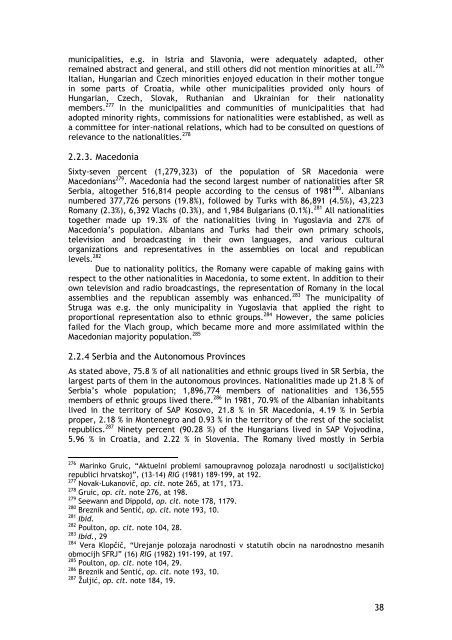Theory and practice of human Rights and minority rights ... - EURAC
Theory and practice of human Rights and minority rights ... - EURAC
Theory and practice of human Rights and minority rights ... - EURAC
Create successful ePaper yourself
Turn your PDF publications into a flip-book with our unique Google optimized e-Paper software.
municipalities, e.g. in Istria <strong>and</strong> Slavonia, were adequately adapted, other<br />
remained abstract <strong>and</strong> general, <strong>and</strong> still others did not mention minorities at all. 276<br />
Italian, Hungarian <strong>and</strong> Czech minorities enjoyed education in their mother tongue<br />
in some parts <strong>of</strong> Croatia, while other municipalities provided only hours <strong>of</strong><br />
Hungarian, Czech, Slovak, Ruthanian <strong>and</strong> Ukrainian for their nationality<br />
members. 277 In the municipalities <strong>and</strong> communities <strong>of</strong> municipalities that had<br />
adopted <strong>minority</strong> <strong>rights</strong>, commissions for nationalities were established, as well as<br />
a committee for inter-national relations, which had to be consulted on questions <strong>of</strong><br />
relevance to the nationalities. 278<br />
2.2.3. Macedonia<br />
Sixty-seven percent (1,279,323) <strong>of</strong> the population <strong>of</strong> SR Macedonia were<br />
Macedonians 279 . Macedonia had the second largest number <strong>of</strong> nationalities after SR<br />
Serbia, altogether 516,814 people according to the census <strong>of</strong> 1981 280 . Albanians<br />
numbered 377,726 persons (19.8%), followed by Turks with 86,891 (4.5%), 43,223<br />
Romany (2.3%), 6,392 Vlachs (0.3%), <strong>and</strong> 1,984 Bulgarians (0.1%). 281 All nationalities<br />
together made up 19.3% <strong>of</strong> the nationalities living in Yugoslavia <strong>and</strong> 27% <strong>of</strong><br />
Macedonia’s population. Albanians <strong>and</strong> Turks had their own primary schools,<br />
television <strong>and</strong> broadcasting in their own languages, <strong>and</strong> various cultural<br />
organizations <strong>and</strong> representatives in the assemblies on local <strong>and</strong> republican<br />
levels. 282<br />
Due to nationality politics, the Romany were capable <strong>of</strong> making gains with<br />
respect to the other nationalities in Macedonia, to some extent. In addition to their<br />
own television <strong>and</strong> radio broadcastings, the representation <strong>of</strong> Romany in the local<br />
assemblies <strong>and</strong> the republican assembly was enhanced. 283 The municipality <strong>of</strong><br />
Struga was e.g. the only municipality in Yugoslavia that applied the right to<br />
proportional representation also to ethnic groups. 284 However, the same policies<br />
failed for the Vlach group, which became more <strong>and</strong> more assimilated within the<br />
Macedonian majority population. 285<br />
2.2.4 Serbia <strong>and</strong> the Autonomous Provinces<br />
As stated above, 75.8 % <strong>of</strong> all nationalities <strong>and</strong> ethnic groups lived in SR Serbia, the<br />
largest parts <strong>of</strong> them in the autonomous provinces. Nationalities made up 21.8 % <strong>of</strong><br />
Serbia’s whole population; 1,896,774 members <strong>of</strong> nationalities <strong>and</strong> 136,555<br />
members <strong>of</strong> ethnic groups lived there. 286 In 1981, 70.9% <strong>of</strong> the Albanian inhabitants<br />
lived in the territory <strong>of</strong> SAP Kosovo, 21.8 % in SR Macedonia, 4.19 % in Serbia<br />
proper, 2.18 % in Montenegro <strong>and</strong> 0.93 % in the territory <strong>of</strong> the rest <strong>of</strong> the socialist<br />
republics. 287 Ninety percent (90.28 %) <strong>of</strong> the Hungarians lived in SAP Vojvodina,<br />
5.96 % in Croatia, <strong>and</strong> 2.22 % in Slovenia. The Romany lived mostly in Serbia<br />
276<br />
Marinko Gruic, “Aktuelni problemi samoupravnog polozaja narodnosti u socijalistickoj<br />
republici hrvatskoj”, (13-14) RIG (1981) 189-199, at 192.<br />
277<br />
Novak-Lukanovič, op. cit. note 265, at 171, 173.<br />
278<br />
Gruic, op. cit. note 276, at 198.<br />
279<br />
Seewann <strong>and</strong> Dippold, op. cit. note 178, 1179.<br />
280<br />
Breznik <strong>and</strong> Sentić, op. cit. note 193, 10.<br />
281 Ibid.<br />
282 Poulton, op. cit. note 104, 28.<br />
283 Ibid., 29<br />
284 Vera Klopčič, “Urejanje polozaja narodnosti v statutih obcin na narodnostno mesanih<br />
obmocijh SFRJ” (16) RIG (1982) 191-199, at 197.<br />
285 Poulton, op. cit. note 104, 29.<br />
286 Breznik <strong>and</strong> Sentić, op. cit. note 193, 10.<br />
287 Žuljić, op. cit. note 184, 19.<br />
38

















